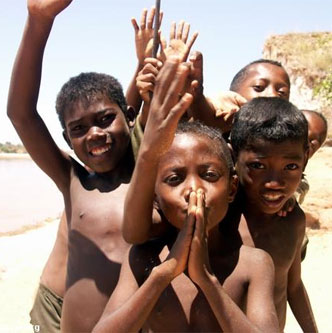“Are Any Among You Sick?” Health, Healing and the Church – by Cynthia Holder Rich
Read Gary Gunderson’s Essay, “Faith, Health, and the Vitality of the Church”
I lived for six years in Madagascar, where many Christians believe in and rely upon the power in the name of Jesus to heal and to save – constructs understood not only as aligned or similar but the same. Living with those who hold this belief has informed my understanding of this week’s topic.
Madagascar is a very poor country (generally understood as among the bottom five nations worldwide), and medical care services (along with food, stores, roads, schools and other services) are scarce in many areas. 19th century mission agencies introduced hospitals and clinics in many areas where they were unknown; in many areas (particularly outside the cities), these institutions continue as the sole source of health care informed by western understandings. These institutions and the personnel who serve them, both missionary and Malagasy health care professionals, do a good and great work, truly heroic, every day of the year. But the health care needs on the island are sufficiently profound to overwhelm any system built to date. Desertification and erosion contribute to a loss of already-scarce arable land. Sanitary procedures are not observed in many areas; the infrastructure necessary to ensure a safe water supply does not exist over most of the island. A high birth rate, gross poverty levels, malnutrition, and high rates of TB, malaria, respiratory and diarrheal diseases create problems and drain life from many Malagasy people. While infection is not comparable to much of the rest of sub-Saharan Africa, growing HIV diagnosis rates deeply concern health professionals, both in and out of the country.
In the midst of deep levels of human suffering, an indigenous Christian movement arose in the 19th century with a vocation in healing ministries. Participants operate in camps and congregations and employ a number of strategies to address the presence of disease and disorder, especially mental illness. Two of these are prayer in the name of Jesus and living in community with people living with mental illness, thus encouraging social engagement and a sense of belonging for people accustomed to outcast status and to being shunned by society.[1]
Understandings of why Jesus came to earth, the purpose or purposes God had/has in the Incarnation, are diverse and many. These theories, called by theologians Christologies, are impacted by culture, history, and experience with Jesus, Jesus’ ministry and the people who follow Jesus. In much of Africa, where many countries are poor and health care services are hard to find or nonexistent, a Christology of Jesus as healer, and a linking of Jesus’ power to heal and power to save, are primary. Madagascar matches many other African contexts, and the power of Jesus to heal is accepted as foundational, unequivocal truth by Christians in the country.
Much of mission Christianity shared a different Christology, one which delinked Christ’s power to heal (the work of mission doctors and nurses) and Christ’s power to save (the work of pastors). That is, what happened in the hospital, healing, and what happened in the churches, saving – the relationship between the two was not made clear, and many missionaries and mission agencies did not affirm nor acknowledge a relationship. The proclamation of the Gospel was done in order to introduce Jesus and his saving power to people. Health care ministries were offered because of love and in response to Biblical commandments to care for those in need; to the extent to which people who came for care felt that they had encountered Jesus in their healing and expressed that to medical missionaries, in most cases they would have been referred to the local pastor or church.
The Christological understanding brought by the missionaries was accepted in their home contexts, and the foundation may be based in centuries of tradition in biblical translation. Morton Kelsey notes that the Latin word salvare, which means to save, was used in the text above from James to translate the Koine Greek word σωσɛι (sosei), which can be translated “to save, to cure and/or to heal”. In western Christianity, this led, Kelsey argued, to centuries of emphasis on spiritual salvation in interpretation, rather than affirming the discussion of physical, bodily illness and healing in the passage. Kelsey maintains that this contributed to a body-spirit dichotomy in the Church and movement away from an understanding of healing as central to the practice of following Jesus.[2]
But the text above and other New Testament healing stories present healing and saving in the same breath and the same way. Many observers have noted the “New Testament perspective” common in much of African Christianity. In Madagascar, the context in that part of the world I know best, the stories of Jesus and the life he and his followers lived is coherent. Poverty and powerlessness, coupled with the violent, corrupt brutality of those in government – these 1st century realities laid out in the Gospel narrative are matched frame by frame in life today on the island.
And in this context, so difficult for so many, the power of Jesus to save and heal has proven effective and reliable. Indeed, as every other power has proved deficient, Jesus is understood as the only hope in life and death.
While churches the world over have for centuries sponsored health care ministries, many western Christians and traditions have bought into the separation of healing and salvation, and this has led to a loss of meaning, power, and capacity in ministry. Where churches in the US and Europe have claimed or reclaimed Jesus’ power to heal (and there are increasing numbers of leaders and ministries where this is happening), the resulting unity has lifted ministry in a holistic and life-affirming way. We live in a world that needs holistic, life-affirming good news. The church is in a position to offer this good news. May we have the courage and the wisdom so to do.
Read Gary Gunderson’s Essay, “Faith, Health, and the Vitality of the Church”
[1] The Fifohazana impacts much of Christian practice on the island; see Cynthia Holder Rich, ed., The Fifohazana: Madagascar’s Indigenous Christian Movement, Cambria Press, 2008.
[2] Morton Kelsey, Healing and Christianity in Ancient Thought and Modern Times. New York: Harper and Row, 1973; 115-117.


